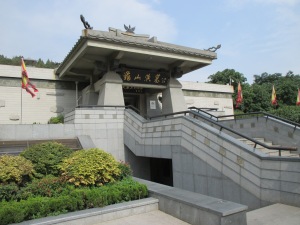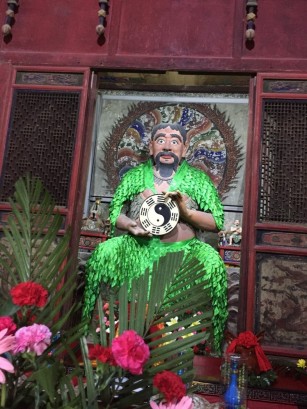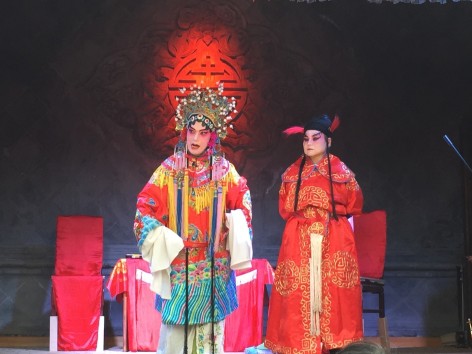Blog Archives
Tullie House heads East … Part Two
Andrew, our Head of Collections and Programming recently traveled to China with our Learning and Engagement Manager Anna, who has written a blog about working with a couple of museums on how to engage with children and young people.
After Anna headed back to the UK, Andrew stayed in China to experience some more of the country’s rich heritage and culture. He’s written a short blog to let us know what he got up to.
…after leaving Anna in Suzhou I traveled to Shanghai, then flew 856 miles to Xi’an, home of the famous Terracotta Warriors, and then took a five hour bus journey (of only 215 miles) through the mountains to the small city (only 3.5m residents!) of Tianshui in Gansu Province.
I intended to visit Tianshui to experience what was described as the ‘Silk Road Festival’ but what turned out to be an annual celebration of Fuxi (pronounced Foo-she), the ‘founder’ of Chinese culture. Fuxi is a cultural hero in China credited with creating humanity and the invention of hunting, fishing and cooking as well as Ying & Yang and the system of writing Chinese characters.
Because Tianshui is so isolated from the more industrialised east coast of China very few people have seen a western person. This made me extremely popular and a major draw for photographers, TV companies and even people wanting a ‘selfie’ with a visitor from the West!
Tianshui also has several museums and I visited three. The Folk Art Museum is located in a traditional Chinese house which comprises several rooms around open courtyards. The museum displayed historic artefacts in their original setting so the kitchen had material from the Quing Dynasty (nineteenth century) and the bedroom had a period box bed and so on. In addition to the roomsets the museum also had a room for showing shadow puppet performances and a theatre for showing traditional Chinese Opera.
The City Museum is linked to the Fuxi temple and has hugely impressive archaeology and history collections but has very little by way of interpretation or engagement – it seems that visitors are expected to know or understand a certain amount of history, which may be true for local people but is certainly not the case when it comes to international visitors.
I met with Mr Lee the museum’s Director and gave a presentation on Tullie House to his staff. Mr Lee explained that the museum (which is roughly the same size as Tullie House) has 200 staff (Tullie has less than 50) and attracts about 30,000 visitors per year (Tullie has 270,000). Mr Lee showed me the museum’s new temporary exhibition gallery which was displaying a collection of artwork from a famous but recently deceased Chinese artist (which I wasn’t allowed to photograph). The aim was to attract new or repeat visitors to the museum through the temporary exhibition programme. However, Mr Lee felt that this first exhibition wasn’t necessarily a success.
The third museum I visited was directly opposite the Folk Art Museum and was owned by the City Council but run through a management agreement by the Shan family. Mr Shan Snr is a highly regarded artist and successful businessman and his son (my host for the week) runs a business from Guangzhou promoting artists and cultural projects. Mr Shan’s museum is, like the Folk Art Museum, located in an historic house. It features artwork and a fabulous historic book collection but it is also significantly lacking collections and any real purpose. The Shan’s have therefore asked Tullie House for their ideas on how the museum might develop. There may well be more to report on this in the future…
Andrew Mackay, Head of Collections and Programming
Tullie House’s work with museums in China is ongoing – keep an eye out for exciting partnerships and events coming up!
Tullie House heads East…
Since 2013, we’ve been working with the Zhou family, owners and operators of the Imperial Decree Museum (IDM) in Xuzhou and the No. 1 Scholar Museum in Suzhou, both in Jiangsu Province in China.
In June of this year we were invited over to show museum staff how objects from collections can be used to engage and inspire. Andrew Mackay (Head of Collections & Programming) and Anna Smalley (Learning & Engagement Manager) made the 7,700 mile journey to Shanghai and this is what happened on their trip…
 After a very long journey we arrived in Shanghai and hopped straight on the famous Chinese Bullet Train to Xuzhou, a relatively “small” city for China with a population of 10 million and rising! We spent the first few days of our trip getting to know the Guishan Hill Scenic District where the Imperial Decree Museum is located. Along with IDM, the area also has a beautiful garden sculpture museum and an amazing Han Dynasty tomb of national importance. The tomb dates back to 116BC and is the resting place of the Emperor Liu Zhu.
After a very long journey we arrived in Shanghai and hopped straight on the famous Chinese Bullet Train to Xuzhou, a relatively “small” city for China with a population of 10 million and rising! We spent the first few days of our trip getting to know the Guishan Hill Scenic District where the Imperial Decree Museum is located. Along with IDM, the area also has a beautiful garden sculpture museum and an amazing Han Dynasty tomb of national importance. The tomb dates back to 116BC and is the resting place of the Emperor Liu Zhu.
 On our fifth day we ran our object handling workshop for 21 local primary school children (10-12 years old) who luckily for us were selected for their English abilities! We created a session based around three activities: firstly, the children took part in an object handling session using the Roman artefacts from our collection which were split into categories of Technology (pottery, glass), Jewellery (brooches and bracelets) and Coins. Secondly, the children explored Latin and Roman writing using real wooden writing tablets and metal styli, having a go at writing in Latin and comparing the results with English and Chinese characters. Thirdly, the children looked at Roman costume, handling real Roman footwear and dressing up in replica costume. The pupils then created their own role play about daily life in Roman Carlisle, using the objects they had handled during the session as inspiration.
On our fifth day we ran our object handling workshop for 21 local primary school children (10-12 years old) who luckily for us were selected for their English abilities! We created a session based around three activities: firstly, the children took part in an object handling session using the Roman artefacts from our collection which were split into categories of Technology (pottery, glass), Jewellery (brooches and bracelets) and Coins. Secondly, the children explored Latin and Roman writing using real wooden writing tablets and metal styli, having a go at writing in Latin and comparing the results with English and Chinese characters. Thirdly, the children looked at Roman costume, handling real Roman footwear and dressing up in replica costume. The pupils then created their own role play about daily life in Roman Carlisle, using the objects they had handled during the session as inspiration.
 The children found the experience of object handling incredibly inspiring: none of the pupils had ever handled real historical artefacts before, and the added factor of them being from a country thousands of miles away was even more exciting! We adopted the same object handling techniques as we would in our primary workshops in Carlisle, telling to the children not to worry about giving wrong answers: we wanted their ideas and to know how they felt about the objects. We encouraged them to use their senses, looking closely with magnifying glasses, feeling for different textures and even smelling the objects.
The children found the experience of object handling incredibly inspiring: none of the pupils had ever handled real historical artefacts before, and the added factor of them being from a country thousands of miles away was even more exciting! We adopted the same object handling techniques as we would in our primary workshops in Carlisle, telling to the children not to worry about giving wrong answers: we wanted their ideas and to know how they felt about the objects. We encouraged them to use their senses, looking closely with magnifying glasses, feeling for different textures and even smelling the objects.
 Next we travelled to Suzhou, known as ‘the Garden City’ and just half an hour by train from Shanghai. Our workshop here was for university students so we adapted our Romans workshop and added comparisons with Han Dynasty technology and costume. Once again the object handling was the most popular activity: the students loved wearing the gloves and handling the objects directly, and were particularly impressed by the jewellery. We also gave the students opportunities to try on the replica costume we brought, working with Han Dynasty re-enactors to compare the different types of male and female clothing. For the writing task the students wrote Latin and Chinese phrases on traditional fans.
Next we travelled to Suzhou, known as ‘the Garden City’ and just half an hour by train from Shanghai. Our workshop here was for university students so we adapted our Romans workshop and added comparisons with Han Dynasty technology and costume. Once again the object handling was the most popular activity: the students loved wearing the gloves and handling the objects directly, and were particularly impressed by the jewellery. We also gave the students opportunities to try on the replica costume we brought, working with Han Dynasty re-enactors to compare the different types of male and female clothing. For the writing task the students wrote Latin and Chinese phrases on traditional fans.
As well as delivering workshops, presentations and meeting lots of new museum colleagues, we also worked on our plans for Chinese New Year 2016 – we hope to borrow items from the Imperial Decree Museum’s collection so keep an eye on the Tullie House website for more details!
Keep an eye on the blog for part 2 of our round up of the trip as Andrew continued to explore the culture and history of China, coming soon.






